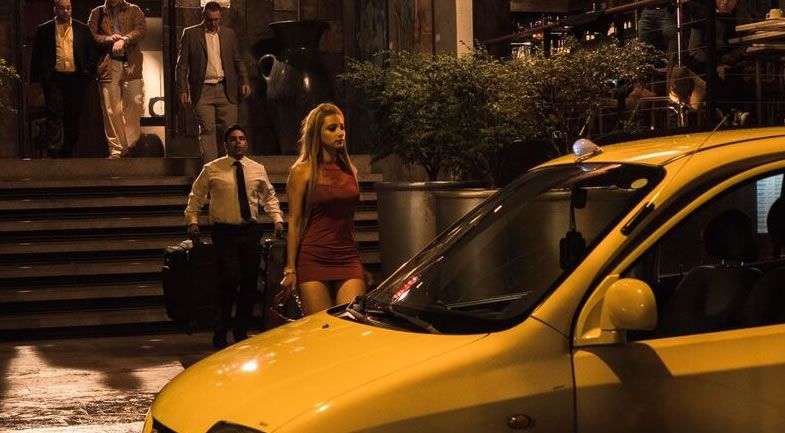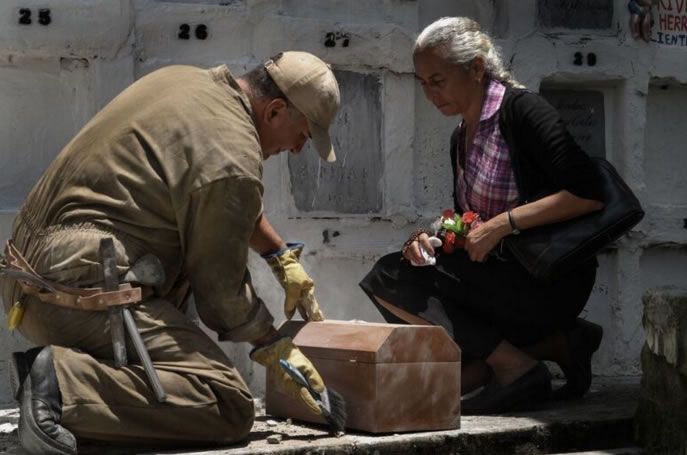Two living statues working at the same park strike up a flirtatious conversation. A still-grieving mother learns the cemetery where her son’s remains are kept will be demolished. A “prepago” girl eager to pay off a man who’d secured her Spanish visa, spends the night with a Japanese client at a hotel. The three stories that make up Carlos César Arbeláez’s latest film, Eso que llaman amor (That Thing Called Love) are variations on a theme. They speak of love, of course. But mostly of loneliness. Set in busy downtown Medellín, this second feature from the Colombian director is a melancholy affair set on Mother’s Day, a holiday that historically has been the city’s most violent day of the year.
Offering a locals-only look at Medellín, from its high-end hotels catering to foreign businessmen to boarding houses where street performers can rent rooms by the night, and making good use of a number of non-professional actors Eso que llaman amor is as authentic a look at the Colombian city as you’re bound to get. While many still associate it with the drug trade and Pablo Escobar, Arbeláez finds his stories instead in the very mundanity of the lives of those trying to get by.
Following its screening at the Miami Film Festival, Arbeláez fielded some questions from the audience. He discussed how a Polish art director influenced his film, why Mother’s Day was the perfect background for these three stories, and what happened to the final fourth storyline that he had to cut. Check out some highlights from that conversation below.
Eso que llaman amor screened as part of the 2017 Miami International Film Festival.
On Shooting a Love Letter to Medellín
This is very different from my first movie, The Colors of the Mountain. I’ve never lived outside the city. I grew up in Medellín. I wanted to shoot a kind of love letter to my city. This is going to sound pretentious, but I wanted to make something like Kieślowski’s Dekalog. To create a film that was almost episodic in its nature. But after a lot of work on the script and attempting to mix these various stories, we kept finding that there were echoes across them. Ultimately we blended them together into what you see here now in A Thing Called Love. A friend of mine who edited the film said that the main theme of the film wasn’t love but solitude. And I found a line from García Márquez, whose work I have to admit I don’t love as much, that reads “When you know solitude you know love” and vice versa. So this film is about how those two overlap. I wanted to honor my city in a way that if you were sitting in a bar, you’d start to wonder about the people around you. About their stories. In a way, the message is that a city is in itself a number of cities. There’s a universality there, in seeing these characters in Medellín.

On Celebrating Motherhood
This movie is about love but it’s mostly about love parents have towards their children. In Medellín and in Antioquia, the province I grew up in in Colombia, the mother is a key figure in our culture. For us paisas, motherhood is central. Curiously, Mother’s Day in Colombia is also one of the most violent days of the year. I don’t really know why. It’d make for an interesting sociological study. It may not be anymore but for a long time it was the bloodiest day of the year. When the mother comes home with the remains of her child, it’s a way to think about all those bodies of all those sons during our years of conflict who are finally coming home. So what happens when all those sons come home that way? What does it say about our country? I was curious to think through those images and through that history, really. I also designed that story about the two living statues as a love metaphor, where every time they shed their costumes they begin to show themselves as they are to one another. They get to show what’s underneath.
On His Choice to Use Non-Professional Actors
Like many other Colombian filmmakers, I choose to use non-professional actors. It’s something that rubs a lot of actors in the country the wrong way. A lot of people think we use non-professional actors because they’re cheaper than professional actors, but in many ways they’re actually more expensive. You know, the choice to use non-professional or professional actors is ultimately an artistic choice. Here I used a mix. It’s half and half. The “prepago” girl had never worked as an actor before. Neither had the Japanese guy. But then the older actors, one of them is actually the director of one of the most well-known theater groups in Colombia, the Teatro Matacandelas. Every film demands what kind of actors you use. My first film, since it was so focused on people from the countryside, I benefitted from using non-actors, but here I needed more variety. Also, that first film had a documentary vibe. Here we rehearsed a lot with the script that was in place and felt much more like a truly fiction film.

On the Fourth Story That Was Cut From the Film
The title is a bit ironic because all the characters end up alone. But I thought it’d be really cool to shoot a love film where everyone just ends up out on the streets, almost. It’s a rather pessimistic take on love, I guess. The film we shot it in just over 5 weeks in Medellín. What’s interesting is that we originally shot four stories—that was the way I’d written the script. I wrote four stories and shot all of them. But when we were in the editing room, we decided to nix that fourth one because it made the film feel too long and a lot of international buyers who’d seen the original cut cautioned us that it’d be in our best interest to cut one of the segments loose. Maybe when we release the DVD we’ll be able to include it.







